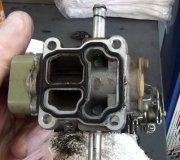When an idle air control valve fails it can cause the engine to idle erratically and even stall. Sometimes a weak idle air control motor will can cause engine problems without triggering a MIL (check engine) light. Inspect vacuum lines when servicing the idle air control valve and replace any that are broken or dilapidated.
Lets' Jump In!
Step 1 - The idle air control valve is located on the throttle bore (in most cases) and is designed to adjust engine air intake at idle which controls the engine idle speed. The PCM receives feedback data from various sensors to send output signals designed to adjust the air passage open or closed which adjusts the engine idle speed. At engine speeds above idle, the valve is not used and does not effect the engine. Engine idle speeds are not adjustable.
Step 2 - Internal air ports are used to regulate the volume of air allowed to pass through the valve. Some valves feature a coolant passage used to heat the valve for improved economy. These ports are sealed using a gasket which prevents the valve from leaking.
Step 3 - Air passage bypass ports are used to route air past the butterfly and through the idle air control valve.
Step 4 - Because of the massive amounts of air processed through the valve a condition called "coking" develops which can inhibit proper operation of the valve. This valve should be cleaned (serviced) whenever a tune up is performed.
Watch the Video!
Please watch this video of the job being done, then continue down the guide to glean additional helpful information.
Questions?
Our certified technicians are ready to answer idle air control valve questions for free. We hope you saved money and learned from this guide. We are creating a full set of car repair guides. Please subscribe to our 2CarPros YouTube channel and check back often for new videos which are uploaded regularly.






